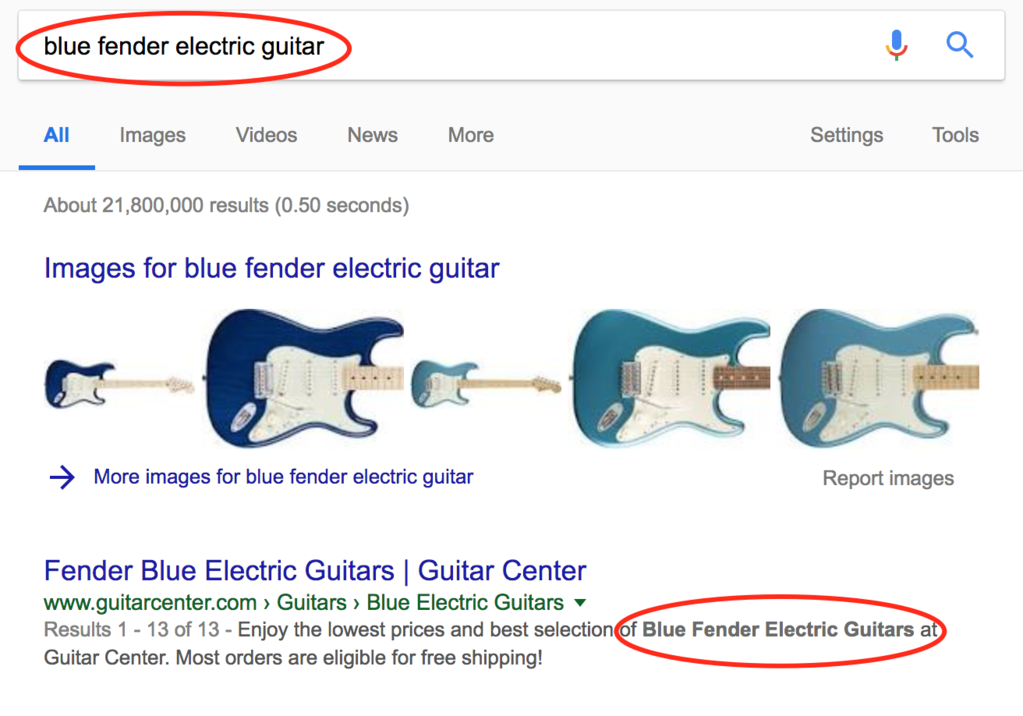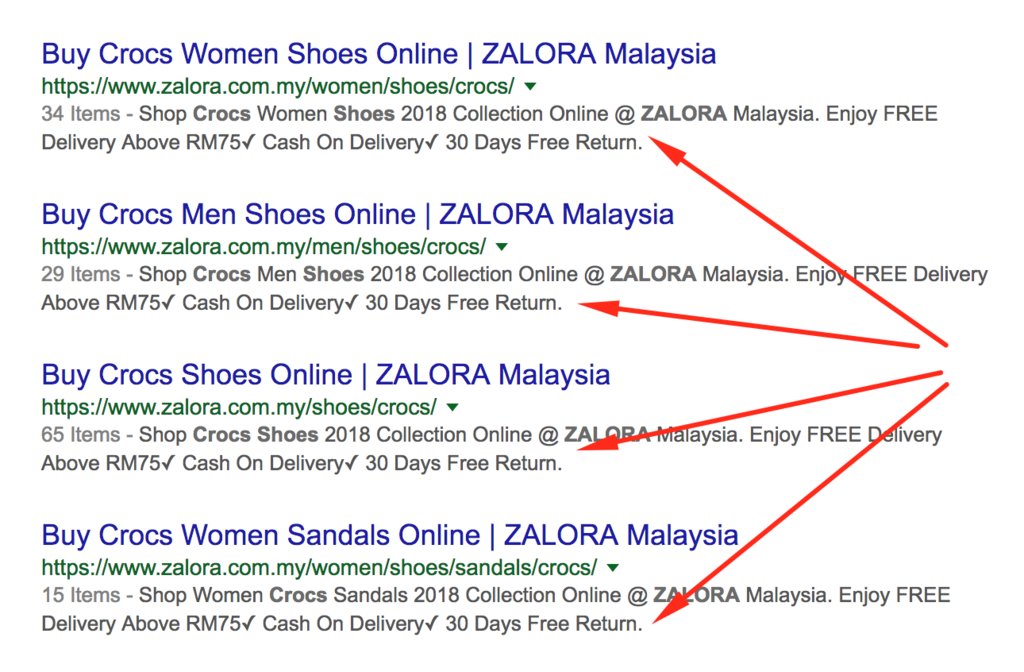Most online business owners make the mistake of auto-generating their store page descriptions. Boosting your online store SEO using descriptions is easier if you write your own. With well-crafted descriptions, you should expect better click-through rates, reduced bounce rates, and increased sales.
You can think of meta descriptions as another opportunity to “advertise” your store’s content to searchers, and for searchers to decide whether your content is relevant to them.
Meta descriptions affect your store rankings indirectly. How? A good meta description increases your click-through rate, and a high click-through rate will improve your keyword ranking.
In other words, a compelling meta description causing a high click-through rate will result in much better search engine rankings.
So long as you know some key factors, writing good ones becomes easy and boosts your online store SEO, store traffic, and sales.
If you want to know how to edit or change your metadata in Shopify, you can find our step-by-step guide here.
How To Write Meta Descriptions for SEO
We’ll look at Meta Descriptions because that’s where we see the most problems.
Think about how often you do searches online. You’re probably already reading dozens of good (and bad) examples of these titles and descriptions every single day.
Most people leave their descriptions as the default view, and while the default is better than nothing, it’s never as good as writing your own. A page description should always read naturally and use the keywords that page is targeting, but also be a compelling description that people will want to click.
Remember you’re telling people who are searching that “mine is the page you’re looking for!”

1. Write Really Good Ad Copy
Excellent descriptions appear simple but contain a range of elements. Structuring the description around your keyword is a great idea so long as it still reads naturally.
Did you ever see the game show Jeopardy? In it, contestants are given the answers as clues, and they must guess the correct question for that answer. Yes, it’s backward.
When it comes to search engines, we start with the answer, this is your page, and your keywords are your best guesses as to what questions (search queries) people will use to find your page. Then, we use those keywords in the description to show to searchers and increase click-through-rates to your page.
First, look at your page, write your keywords down based on your page as a whole, then set about writing around those keywords by thinking of the intent behind the search query you think will be popular.
The key is to boosting your online store SEO using descriptions is to write your title and meta description just like mini-advertisements. Mini means less work than long.
2. Use Keywords
If the search query is in the description, Google will bold it. Your keywords are a ‘search query’ that you think people will be typing into their search engine to find your store.
The bold text draws the eyes of searchers to it, so your descriptions should match to search queries as closely as possible.
 Example: Here you can see the search query in google returns the first result from guitarcenter.com with the search query bolded.
Example: Here you can see the search query in google returns the first result from guitarcenter.com with the search query bolded.
3. Look at Your Length
In Shopify, the default description is often too long and cuts off in places that don’t always make sense.
Page descriptions can be any length, but Google displays around 320 characters or less. For example, if you put up a blog post, Google shows the date, and that will reduce the number of characters displayed.
You’ll want your descriptions long enough that they thoroughly cover what you want to say about your page, but to the point without fluff.
If you are boosting your online store SEO using descriptions the “best” length will vary, but your primary goal is always the same: You should be providing value and driving clicks to your store.
4. Be Unique, Avoid Duplicating
It’s tempting to save time and duplicate your descriptions especially if you have many products, but there’s no substitute for original descriptions.
Think about this from the searchers perspective, they type in a query and results have shown have different titles, but the page content looks the same. They wonder, if you are a spammy robot making click bait pages, so they don’t click.
You’re better leaving additional pages blank because each page of your store should be trying to rank for a different keyword, and so each page description is going to be targeting a slightly different search query.
If you copy and paste your page descriptions and they are pretty much all the same, they won’t be targeted enough to a specific keyword.
We searched here for Crocs shoes and found this store on page twenty-something. Apparently, people are still buying crocs these days; this store could do much better with their descriptions.
5. Avoid copying others
Search for your targeted keywords in Google to see what other sites do. Then, write something different.
Amateur SEO ‘experts’ advise to take a shortcut where you just copy what the top ranking websites are doing, but this is ineffective. Boosting your online store SEO using descriptions means being unique.
Why? Because duplicate content, isn’t good content. Not only is it poor marketing practice, but now you’re competing with those top sites.
6. Avoid Keyword Stuffing
Technology is sophisticated in detecting the difference between natural language and forced spammy keyword stuffing. Keyword stuffing is bad and probably comes from an out of date understanding of SEO.
When search engines see repetitive variations of terms, it throws up red flags and penalizes your page. Your description should be functioning like advertising copy, so avoid keyword stuffing. Here’s a keyword stuffing example we found. It’s ugly and doesn’t make people want to click on it.
Here’s a keyword stuffing example we found. It’s ugly and doesn’t make people want to click on it.
7. Don’t Deceive
If your page description deceives the reader with content that’s not relevant to what they expect they’ll hit the ‘Back’ button, and search engines see this and will penalize your page. Visitors quickly using the back button is referred to as a ‘bounce rate,’ and high bounce rates result in poor SEO.
Your page description should be directly relevant to the page it describes.
8. Experiment With Half Sentence Hangs…
Some people say your meta descriptions should all finish with complete sentences.
But, once you know how to write descriptions you can start to experiment with the half-sentence… it can leave people hanging, wanting to know what comes next because there is an information gap and increase your click-through rate. The reader is planning a party and looking for a great cupcake stand, but now they must find out what’s better than a cupcake stand to make their party better?????
The reader is planning a party and looking for a great cupcake stand, but now they must find out what’s better than a cupcake stand to make their party better?????
What To Write For Your Homepage Description
Good descriptions give searchers an overview of what the site is about and a real reason to click on your title. It’s just like what you would say in an elevator pitch – brief and clear.
Here are things to include on your homepage.
- Giving the reader an idea of what you’re selling, the readers want to know what you do
- Positioning yourself as an e-commerce store – because that’s what you are and you want people clicking in with the goal of buying, you’re not an info site.
- Backing up your claim, so you sound credible and reputable.
- Distinguishing products you sell from your competition. Telling searchers about qualities of your products that make them stand out or be unique, for example organic, quality, specialty
- Repeating your core ideas, convey the same information multiple times. By stating the same thing in different ways, you’ll be reinforcing your message and compelling people.
- Remember that the home page description isn’t subtle, you have limited characters to get your points across, so don’t beat around the bush.
 Boosting your online store SEO using descriptions on your home page is a way to really stand out. Think about what your brand is all about. What image and core values are you looking to portray.
Boosting your online store SEO using descriptions on your home page is a way to really stand out. Think about what your brand is all about. What image and core values are you looking to portray.
If you get stuck and you’re an established store, ask what do return customers say about your business, about your service, about your products in general?
And if you’re new, why you think this business would get customers? What sets your store apart?
Take your time if you need to write this homepage description. It’s short but essential.
If you want to know where to edit your home page, check out our step-by-step article here.
What To Write For Product Page Descriptions
People often find that writing product page descriptions easier than writing descriptions for their home page.
Someone reading a well-written description doesn’t make a calculated decision. The reader is merely clicking on the link, without really thinking about it.
It’s all about spelling out what your product is, why people should buy it and what differentiates your product.
1. Focus on Benefits to the Customer

The focus of a well-written product page description shows the benefit of your product to the customer.
People don’t buy ‘things.’ What they’re buying are solutions to their problems and fulfillment of their needs and wants.
So your product either provides a solution:
If you’re selling cake mixers: Your customer doesn’t buy your cake mixer, your customer is buying a solution to the problem of cake mixing being a long and inconvenient task. They are buying baking that is quicker, easier, virtually effortless.
Or your product fulfills a want or need:
If you’re selling luxury watches: Your customer doesn’t buy your watch solely to tell time. They’re buying the stylish feeling they’ll get when wearing the piece, the comfort of the strap on their wrist and they’re buying precision in the mechanics.
2. Use Visualization, so They Imagine Having Your Product
Letting the customer visualize themselves with the product is a powerful tool. Visualisation involves telling them what emotions they will feel when they have the products and the ways the product could comfortably fit into their life.
Selling fashionable woman’s shoes? Women buy because they think they’ll feel fierce with the sturdiness of the quality on their feet. That other people will associate them with high status or find them sexy. And because of the shoes transitioning from practical daytime workwear into classy nightwear.
3. Show the Problems With Other Products
Use this sparingly; there’s no need to outright slam other products to make your’s appear better; you can be more subtle.
“Our Satin Sheer Exterior paint is made of polymer 29, so our paint never peels” This example sews the seed that “other paints” peel, but that Satin Sheer Exterior doesn’t.
If you have questions or want help, contact us here we have a team of friendly experts.

